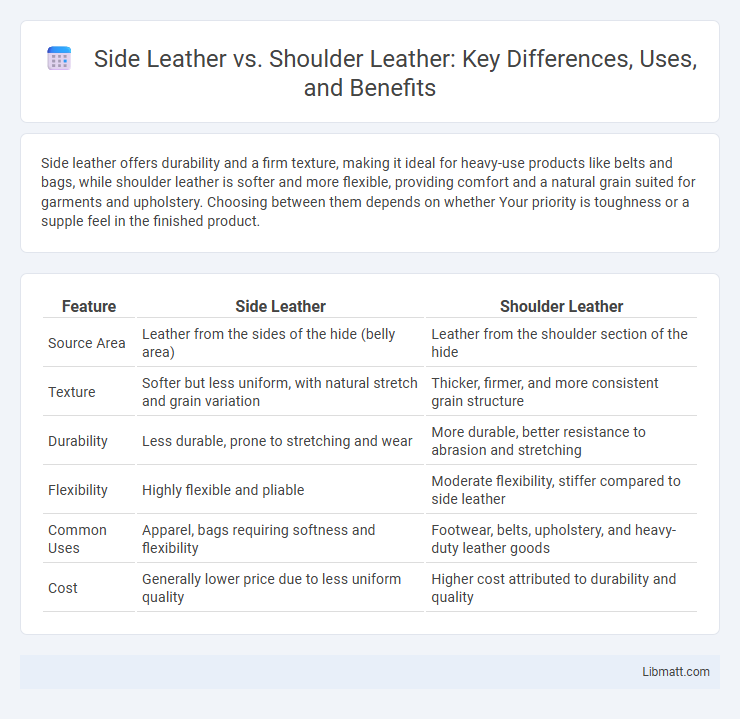Side leather offers durability and a firm texture, making it ideal for heavy-use products like belts and bags, while shoulder leather is softer and more flexible, providing comfort and a natural grain suited for garments and upholstery. Choosing between them depends on whether Your priority is toughness or a supple feel in the finished product.
Table of Comparison
| Feature | Side Leather | Shoulder Leather |
|---|---|---|
| Source Area | Leather from the sides of the hide (belly area) | Leather from the shoulder section of the hide |
| Texture | Softer but less uniform, with natural stretch and grain variation | Thicker, firmer, and more consistent grain structure |
| Durability | Less durable, prone to stretching and wear | More durable, better resistance to abrasion and stretching |
| Flexibility | Highly flexible and pliable | Moderate flexibility, stiffer compared to side leather |
| Common Uses | Apparel, bags requiring softness and flexibility | Footwear, belts, upholstery, and heavy-duty leather goods |
| Cost | Generally lower price due to less uniform quality | Higher cost attributed to durability and quality |
Introduction to Leather Types
Side leather, sourced from the lateral parts of the hide, offers a balance of durability and flexibility, making it ideal for products requiring moderate strength and suppleness. Shoulder leather, taken from the upper front section near the neck, is known for its softness, distinctive grain, and natural markings, often preferred for high-end leather goods and upholstery. Understanding these differences helps manufacturers and consumers select the right leather type tailored to specific applications and aesthetic preferences.
What is Side Leather?
Side leather refers to the section of hide located between the shoulder and the belly of an animal, known for its durability and smooth texture. It offers a balanced combination of thickness and flexibility, making it ideal for high-quality leather goods like shoes, bags, and upholstery. When choosing leather, your selection of side leather ensures a reliable blend of strength and aesthetic appeal.
What is Shoulder Leather?
Shoulder leather is made from the upper part of an animal's hide, known for its durability and natural texture that includes slight grain variations. This type of leather offers a balance between toughness and flexibility, making it ideal for products requiring both strength and a polished appearance. Your choice of shoulder leather ensures long-lasting quality with a distinct, rich character from genuine animal hide.
Sourcing and Anatomy Differences
Side leather is sourced from the sides of the cowhide, offering a more uniform grain and consistent thickness, making it ideal for upholstery and tool crafting. Shoulder leather originates from the shoulder section, characterized by natural grain variations and greater strength due to muscle structure, often preferred for durable goods like bags and footwear. Anatomically, side leather is smoother with fewer imperfections, while shoulder leather displays more wrinkles and natural marks, reflecting its tougher, more flexible nature.
Durability and Strength Comparison
Side leather offers superior durability and strength due to its thickness and tighter fiber structure compared to shoulder leather, which tends to be more flexible but less robust. The dense grain in side leather resists wear and tear better, making it ideal for high-stress applications like saddles and heavy-duty footwear. In contrast, shoulder leather, though softer and easier to work with, may show signs of stretch and abrasion sooner under heavy use.
Flexibility and Workability
Side leather offers superior flexibility due to its thinner and more pliable nature, making it ideal for projects requiring intricate shaping and detailed work. Shoulder leather, while thicker and stiffer, provides enhanced workability for items needing durability and structural integrity, such as belts and straps. Both types excel in versatility, but side leather is preferred for fine craftsmanship, whereas shoulder leather supports robust applications.
Common Uses for Side Leather
Side leather is commonly used in crafting durable leather goods such as shoes, bags, and upholstery due to its balanced grain and thickness, offering a sturdy yet flexible material ideal for everyday wear and tear. Unlike shoulder leather, which tends to be more textured and elastic, side leather provides a smooth, consistent surface that holds shapes well, making it perfect for structured items like wallets and belts. When choosing leather for your projects, side leather's versatility ensures both aesthetic appeal and long-lasting performance.
Typical Applications for Shoulder Leather
Shoulder leather is prized for its balance of strength and flexibility, making it ideal for durable goods like jackets, bags, and upholstery that require both resilience and a soft touch. This type of leather often exhibits natural markings and grain variations, adding a unique character to your products while maintaining high abrasion resistance. Its versatility suits items subjected to frequent wear, making shoulder leather a top choice for functional yet stylish applications.
Cost and Availability
Side leather tends to be more expensive due to its higher quality and durability, often sourced from the central part of the hide, which offers fewer imperfections compared to shoulder leather. Shoulder leather is generally more affordable and widely available, as it comes from the upper front part of the animal and may include more markings or grain irregularities. Availability of shoulder leather is higher in mass production markets, while side leather is preferred for premium leather goods requiring better strength and appearance.
Choosing the Right Leather for Your Project
Side leather offers durability and a balanced texture ideal for larger projects requiring toughness, while shoulder leather provides more flexibility and a distinctive grain pattern perfect for detailed work or smaller items. Your choice depends on the project's demands for strength versus flexibility, with side leather excelling in rugged applications and shoulder leather suited for intricate designs. Understanding these differences ensures you select the optimal leather type to enhance your craft's quality and longevity.
Side leather vs shoulder leather Infographic

 libmatt.com
libmatt.com